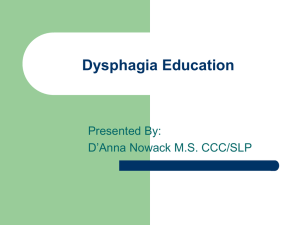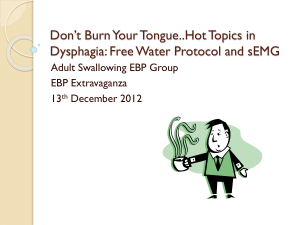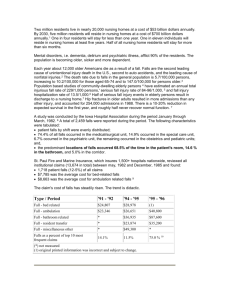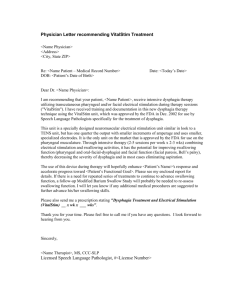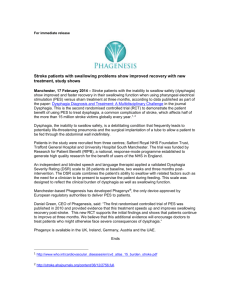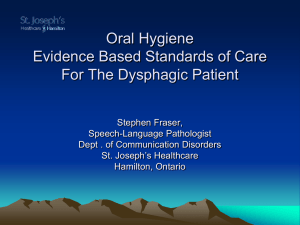Safety of Water - KentuckyOne Health
advertisement
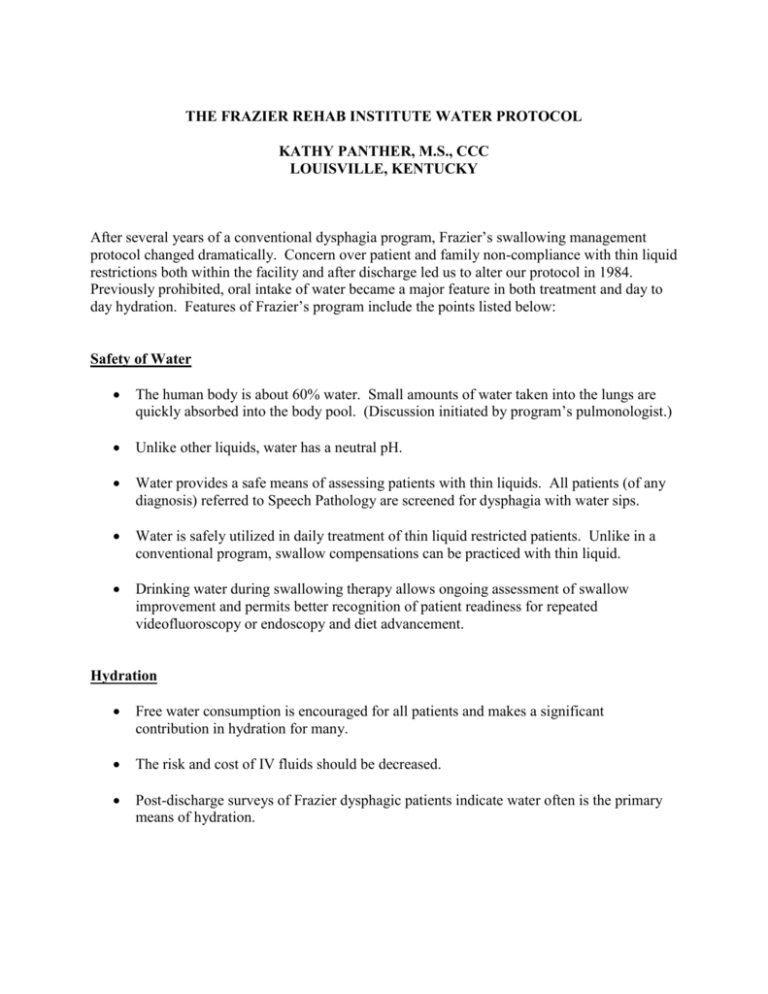
THE FRAZIER REHAB INSTITUTE WATER PROTOCOL KATHY PANTHER, M.S., CCC LOUISVILLE, KENTUCKY After several years of a conventional dysphagia program, Frazier’s swallowing management protocol changed dramatically. Concern over patient and family non-compliance with thin liquid restrictions both within the facility and after discharge led us to alter our protocol in 1984. Previously prohibited, oral intake of water became a major feature in both treatment and day to day hydration. Features of Frazier’s program include the points listed below: Safety of Water The human body is about 60% water. Small amounts of water taken into the lungs are quickly absorbed into the body pool. (Discussion initiated by program’s pulmonologist.) Unlike other liquids, water has a neutral pH. Water provides a safe means of assessing patients with thin liquids. All patients (of any diagnosis) referred to Speech Pathology are screened for dysphagia with water sips. Water is safely utilized in daily treatment of thin liquid restricted patients. Unlike in a conventional program, swallow compensations can be practiced with thin liquid. Drinking water during swallowing therapy allows ongoing assessment of swallow improvement and permits better recognition of patient readiness for repeated videofluoroscopy or endoscopy and diet advancement. Hydration Free water consumption is encouraged for all patients and makes a significant contribution in hydration for many. The risk and cost of IV fluids should be decreased. Post-discharge surveys of Frazier dysphagic patients indicate water often is the primary means of hydration. Compliance Complaints of thirst were frequently voiced prior to 1984. Patients reported thickened liquids did not quench thirst. Water eliminates thirst and patient complaints are now much less frequent. Many patients and families object to thickened liquids. Since water is an option, patients appear more likely to comply with the thin liquids restriction. Once home, preparation of thickened liquids often becomes burdensome. After days or weeks at home the family may tire of patient complaints and abandon thickened liquids. Availability and cost of thickening agents and/or prepackaged thick liquids may preclude patient compliance. Thick liquid preparation, in addition to other time and energy consuming patient care tasks, can overwhelm many families. THE FRAZIER REHAB INSTITUTE WATER PROTOCOL WATER BETWEEN MEALS BY POLICY, ANY ENTERALLY FED PATIENT OR PATIENT ON A DYSPHAGIC DIET MAY HAVE WATER. All patients are screened with water. Patients exhibiting impulsivity or excessive coughing and discomfort will be restricted to water taken under supervision. Patients with extreme choking may not be permitted oral intake of water due to the physical stress of coughing. For patients on oral diets, water is permitted between meals. Water intake is unrestricted prior to a meal and allowed 30 minutes after a meal. The period of time following the meal allows spontaneous swallows to clear pooled residues. After the screening described above, enterally fed patients are often permitted water. Patients who are thin liquid restricted wear pink wristbands to communicate the liquid restrictions to all staff. Typically, the band reads, “No thin liquids except water between meals.” The wording on the band is individualized as appropriate when specific compensations are recommended. For example, a band may read “No thin liquids except water by teaspoon between meals.” All rehab staff are oriented to the pink bands and check for bands before offering liquids to patients. Water is freely offered to patients according to the guidelines documented on the pink bands throughout the day. Patients for whom compensations, i.e. chin tuck, head turn, etc., have proven to be successful are encouraged to use compensations while drinking water. This information is also included on the pink bands. Aggressive oral care should be provided to those patients who are unable to clean their own teeth and mouths so that pathogenic bacteria are less likely to contaminate secretions. Medications are never given with water. Pills are given in a spoonful of applesauce, pudding, yogurt, or thickened liquid. Family education includes emphasis on the rationale for allowing water intake. The Speech-Language Pathologist, Dietician, and Nurse repeat the guidelines for water intake during the education process. Written material is provided as well. Education is documented in the medical record. FRAZIER WATER PROTOCOL REFERENCES Olson, M. (1990). The benign effects on rabbits’ lungs of the aspiration of water compared with 5% glucose or milk. Pediatrics, 46:538-547. Splaingard, M.L., Hutchins, B., Sulton, L.D., Chaudhuri, G. (1988). Aspiration in rehabilitation patients: videofluoroscopy vs bedside clinical assessment. Archives of physical medicine and rehabilitation, 69:637-640. Schmidt, J., Holas, M., Halvorson, K., & Reding, M. (1994). Videofluoroscopic evidence of aspiration predicts pneumonia and death but not dehydration following stroke. Dysphagia, 9:7-11. Holas, M.A., DePipppo, K.L., & Reding, M.J. (1994). Aspiration and relative risk of medical complications following stroke. Neurology, 51:10511053. Robbins, J., Gensler, G., Hind, J., Logemann, J.A., Lindblad, A.S., Brandt, D. et al. (2008). Comparison of 2 interventions for liquid aspiration on pneumonia incidence: a randomized trial. Annals of Internal Medicine, 148, 509-518. Feinberg, M.J., Kneble, J., Tully, J., & Segall, L. (1990). Aspiration and the elderly. Dysphagia, 5(2):61-71. Feinberg, M.J.,, Kneble, J., & Tully, J. (1996). Prandial aspiration and pneumonia in an elderly population followed over 3 years. Dysphagia, 11(2):104-109. Langmore, S.E., Terpenning, M.S., Schork, A., Chen, Y., Murray, J.T., Lopatin, D., & Loesche, W.J. (1998). Predictors of aspiration pneumonia: How important is dysphagia? Dysphagia, 13:69-81. Jette, A.M., Feldman, H.A., & Douglass, C. (1993). Oral disease and physical disability in community-dwelling older persons. Journal of the American Geriatric Society, 41:1102-1108. Azarpazhooh, A. & Leake, J.L., (2006). Systematic review of the association between respiratory diseases and oral health. Journal of Periodontology, 77(9), 1465-1482. Katz, S., & Akpom, A. (1976). A measure of primary sociobiological functions. International Journal of Health Services, 6(3):493-508. Johnson, V, Chalmers, J. (2002). Oral hygiene care for functionally dependent and cognitively impaired older adults. National Guidelines Clearinghouse. Millns, B, Gosney, M, Jack, C.I., Martin, M.V., & Wright, A.E. (2003). Acute stroke predisposes to oral gram-negative bacilli – a cause of aspiration pneumonia? 49(3):173-176. Yoneyama, T., Yoshida, M., Ohrui, T., Mukaiyama, H., Okamoto, H., Hosiba, K., Iharia, S., Yanagisawa, S., Ariumi,S., Morita, T., Mizuno, Y., Ohsawa, T., Akagawa, Y., Hashimoto, K., & Sasaki, H. (2002). Oral care reduces pneumonia in older patients in nursing homes. Journal of American Geriatrics Society, 50(3):430-433. Schleder, B. (2002). The effect of a comprehensive oral care protocol on patients at risk for ventilator associated pneumonia. Journal of Advocate Health, 10(4):27-30. Pace, C., & McCullough, G. (2010). The association between oral microorganisms and aspiration pneumonia in the institutionalized elderly: review and recommendations. Dysphagia, 25(4):307-322. Terpenning, M.(2005). Geriatric oral health and pneumonia risk. Clinical Infectious Diseases. 40(12): 1807-1810. Shay, K. (2002). Infectious complications of dental and periodontal diseases in the elderly population. Clinical Infectious Diseases, 34(9): 1215-1223. Zembrzuski,C. (1997). A three-dimensional appraoch to hydration of elders: administration, clinical staff, and in-service education. Geriatric Nursing, 18:20-26. Sansevero, A.C. (1997). Dehydration in the elderly: strategies for prevention and management. The Nurse practitioner, 22(4):63-66. Chernoff, R. (1994). Thirst and fluid requirements. Nutrition Review, 52:S3. Kleiner, S.M. (1999). Water: An essential but overlooked nutrient. Journal of the American Dietetic Association, 99:200-206. Warren J, Bacon WE, Harris T, McBean AM, Foley DJ, Phillips C. The burden and outcomes associated with dehydration among US elderly, 1991. American Journal of Public Health 1994; 84(8):1265-69. Lavizzo-Mourey RJ. Dehydration in the elderly: a short review. Journal of the National Medical Association 1988; 79:1033-38. Mentes,J. Acute confusion indicators: risk factors and prevalence using MDS data. Research in Nursing and Health 1999; 22(2): 95-99. Gaspar PM. Water intake of nursing home residents. Journal of Gerontological Nursing 1999; 25:23-29. Armstrong-Esther CA, Browne KD, Armstrong-Esther DC, Sander L. The institutionalized elderly: dry to the bone! International Journal of Nursing Studies 1996; 33(6): 619-28. Xiao, H., Barber, J., & Campbell, E.S. (2004). Economic burden of dehydration among hospitalized elderly patients. American journal of health-system pharmacy, 23:2534-2540. Copeman, J. (2000). Promoting nutrition in older people in nursing and residential homes. British Journal of Community Nursing, 5:277-284. Vogelzang, J.L. (1999). Overview of fluid maintenance/prevention of dehydration. Journal of the American Dietetic Assoiation, 99:5. Chidester, J.C., & Spangler, A.A. (1997). Fluid intake in the institutionalized elderly. Journal of the American Dietetic Association, 99:200-206. Gross, C.R., Lindquist, R.D., Woolley, A.C., Granieri, E., Allard, K., & Webster, B. (1992). Clinical indicators of dehydration severity in elderly patients. The Journal of emergency medicine, 3:267-274. Whelan, K. (2001). Inadequate fluid intake in dysphagic acute stroke. Clinical indicators of dehydration severity in elderly patients. Journal of Emergency Medicine, 3:267-74. Finestone, H.M., Foley, N.C., Woodbury, M.G., & Green-Finestone, L. (2001). Quantifying fluid intake in dysphagic stroke patients: a preliminary comparison of oral and nonoral strategies. Archives of Physical Medicine and Rehabilitation, 82:1744-1746. Kositzke, J.A. (1990). A question of balance-dehydration in the elderly. Journal of gerontological nursing, 16:4-11. Davis, J., & Sherer, K. (1994). Applied nutrition and diet therapy for nurses. Philadelphia: W.B. Saunders Company. Hoffman, N.B. (1991). Dehydration in the elderly: insidious and manageable. Geriatrics, 46:35-38. Remington, R. & Hultman, T. (2007). Hypodermoclysis to treat dehydration: A review of the evidence. Journal of the American Geriatrics Society, 55(12): 2051-2055. Meyer, D., Leventhal, H., & Gutmann, M. (1985). Common sense models of illness: The example of hypertension. Health Psychology, 4:115-135. MacDonald, E.T., MacDonald, J.B., & Phoenix, M. (1977). Improving drug compliance after hospital discharge. British Medical Journal, 2: 618-621. Marlatt, G.A., & Gordon, W.H. (1984). Relapsse prevention: Introduction and overview of the model. British Journal of Addiction, 79:261-273. Stone, G. (1979). Patient compliance and role of the expert. Journal of Social Issues, 35:34-59. Leiter, A.E., & Windsor, J. (1996). Compliance of geriatric dysphagic patients with safe-swallowing instructions. Journal of Medical Speech-Language Pathology, 4:289-300. Mayer, J., Skrickova, J., Vorlicek, J., & Kubalek, V. (1994). Use of bronchoalveolar lavage in the diagnosis of pulmonary complications in immunocompromised patients. Vnitrni lekarstvi, 40:179-183. Martin, W.J., Smith, T.F., Sanderson, D.R., Brutinel, W>M., Cocerill, F.R., & Douglas, W.W. (1987). Role of bronchoalveolar lavage in the assessment of opportunistic infections: utility and complications. Mayo Clinic proceedings, 62(7):549-57. Reynolds, H.V. (1998). Bronchoalveolar lavage. In J.T. Murray & J.A. Nadel (Eds.) Textbook of Respiratory Medicine (p598). Philadelphia, PA: W.B. Saunders Co. Effros, R.M. (1997, October). Defense of the lungs following aspiration of acid and hypotonic solutions. Paper presented at Dysphagia Research Society Meeting, Toronto. Kozono, D., Yasui, M., King, L., & Agre, P. (2002). Aquaporin water channels: atomic structure molecular dynamics meet clinical medicine, The Journal of Clinical Investigation, 109(11):1395-1399. Rawls,R. (2001). Watching water line dance: to pass through a membrane pore quickly, H20 must change partners. Chemical and Engineering News, 79(51):14. Schwartz, D.J., Wynne, J.W., Gibbs, C.P., Hood, C.I., & Kuck, E.J. (1980). The pulmonary consequences of gastric contents at pH values greater than 2.5. The American review of respiratory disease, 1212:119-126. Crossley, K.B., & Thum, J.R. (1989). Nursing home-acquired pneumonia. Seminars in respiratory infections, 4:64-72. Whitmire, S.J. (2000). Water, electrolytes and acid-base balance. In L.K. Mahan & S. Escott-Stump (Eds.) Krause’s Food, Nutrition, Diet Therapy (pp153-163). Philadelphia, PA: W.B. Saunders Co. Mashiba, K., Hamamoto, T., & Torikai, K. (1993). A case of Legionnaires’ disease due to aspiration of hot spring water and isolation of Legionella pneumophila from hot spring water. Kansenshogaku Za sshi, 67:163-166. Kool, J.L., Carpenter, J.C., & Fields, B.S. (1999). Effect of monochloramine disinfection of municipal drinking water on risk of nosocomial Legionnaires’ disease. Lancet, 23;353(9149):272-277. Venezia, R.A., Agresta, M.D., Hanley, E.M., Urquhart, K., & Schoonmaker, D. (1994). Infection Control and Hospital Epidemiology, 15(8):529-533. Garon, B.R., Engle, M., & Ormiston, C. (1997). A randomized control study to determine the effects of unlimited oral intake of water. Journal of Neuro Rehab, 11:139-148. Carlaw, C., Finlayson, H., Beggs, K., Visser, T., Marcoux, C., Coney, D., & Steele, C.M., (2011). Outcomes of a pilot water protocol project in a rehabilitation setting, Dysphagia online publication. Frey,K.L. & Ramsberger, G. (2011). Comparison of outcomes before and after implementation of a water protocol for patients with cerebrovascular accident and dysphagia. Journal of Neuroscience Nursing, 43(3):165-171. Karagiannis, M.J.P., Chivers, L., & Karagiannis, T.C. (2011). Effects of oral intake of water in patients with oropharyngeal dysphagia. BMC Geriatrics, 11(9):1-10. Castellanos,V.H., Butler, E., Gluch, L., & Burke, B. (2004). Use of thickened liquids in skilled nursing facilities. Journal of the American Dietetic Association, 104(8):1222-1226. Cichero, J.A., Jackson, O., Halley, P.J. & Murdock, B.E. (2000). How thick is thick? Multicenter study of the rheological and material property characteristics of mealtime fluids. Dysphagia, 15:188-200. Glassburn, D.L., & Deem, J.F. (1998). Thickener viscosity in dysphagia management: Variability among speech-language pathologists. Dysphagia, 13:218-222. Mertz Garcia, J., Chambers, E., & Molander, M., (2005). Thickened liquids: Practice patterns of speech-language pathologists. American Journal of Speech-Language Pathology, 14:4-13. Panther, K.M. (2005). The Frazier Free Water Protocol. Perspectives on Swallowing and Swallowing Disorders (Dysphagia) American Speech-Language-Hearing Association Division 13,4(1):4-9.

